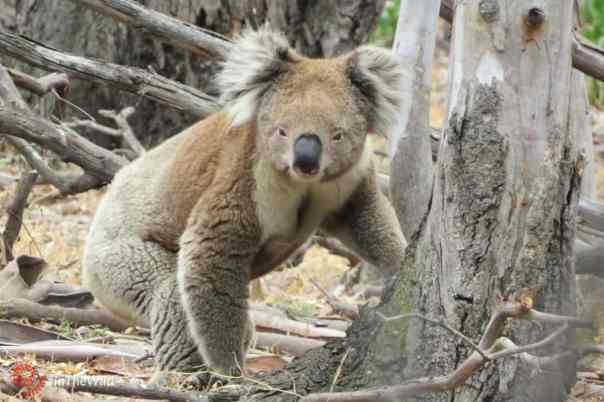Male koalas have home ranges: an area of land that they live in. Depending on their status, they may or may not tolerate other males using part of all of their home range. Dominant males in the You Yangs do not seem to tolerate other males in their home range. They are possibly territorial, which means they defend a long-term home range from other males. (1)
Read about Koala Home Ranges here.
Male koalas will mark their home range with their scent. It is a way of communicating with other koalas. It could be a calling card for females – to attract them – or for other males – to discourage them, or even to say they are willing to fight for this patch.
The following photographs show Lluvia: a 3 year old young, sub-dominant male during breeding season, walking through an area and scent-marking a tree.
The area Lluvia is walking is a home range recently vacated by a dominant male. Lluvia stayed in this area for several months. Two other adult males – a mature male named Zack, and an older male named Cruiz – were also seen in this area over the same months, and sometimes on the same day as Lluvia.

Lluvia approaches a River Red Gum tree.

He stops and sniffs at the base of the tree.

He has a look around. You can see his scent gland – the dark stain in the middle of his chest.

He approaches the tree.

Then prepares to rub his scent gland against it.

That done, he moves on to the next tree.
Koala scent marking becomes more frequent in the breeding season (2), and males are more likely to scent-mark a tree that has been occupied by another male. So Lluvia may have been marking a tree recently used by Zack or Cruiz.
Read more about Koala Scent Glands here, and about Koala Communication by Scent here.
REFERENCES:
1. There is some debate over whether koalas are territorial or not. Territoriality is defined as “the sociographical area that an animal of a particular species consistently defends against conspecifics.” In the You Yangs, some males have very large, long-term home ranges with almost no overlap by the neighbouring males. We consider these to be dominant males. It is possible that these dominant males do defend their home range from other males in some way. Also in the You Yangs, many males have home ranges with a large degree of overlap with other males – we consider these sub-dominant males, and these are not territorial.
2. (1) Ellis, WAH, Melzer A, Bercovitch F “Spatiotemporal dynamics of habitat use by koalas: the checkerboard model” Behav Ecol Sociobiol (2009) 63: 1181-1188





